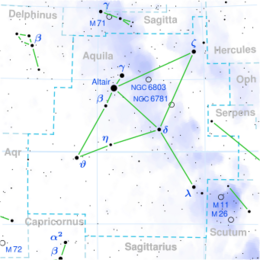Astronomy:27 Aquilae
| Observation data Equinox J2000.0]] (ICRS) | |
|---|---|
| Constellation | Aquila |
| Right ascension | 19h 20m 35.68321s[1] |
| Declination | −00° 53′ 31.8067″[1] |
| Apparent magnitude (V) | 5.49[2] |
| Characteristics | |
| Spectral type | B9 III[3] |
| U−B color index | −0.23[2] |
| B−V color index | −0.04[2] |
| Astrometry | |
| Radial velocity (Rv) | −27[4] km/s |
| Proper motion (μ) | RA: 5.42[1] mas/yr Dec.: 2.83[1] mas/yr |
| Parallax (π) | 7.45 ± 0.28[1] mas |
| Distance | 440 ± 20 ly (134 ± 5 pc) |
| Absolute bolometric magnitude (Mbol) | 2.04–2.27[5] |
| Details | |
| Surface gravity (log g) | 3.61 ± 0.50[6] cgs |
| Temperature | 11,500[6] K |
| Rotational velocity (v sin i) | 55[7] km/s |
| Other designations | |
| Database references | |
| SIMBAD | data |
27 Aquilae (abbreviated 27 Aql) is a star in the equatorial constellation of Aquila. 27 Aquilae is its Flamsteed designation though it also bears the Bayer designation d Aquilae. It has an apparent visual magnitude of 5.49,[2] which is faintly visible to the naked eye. Based upon parallax measurements made during the Hipparcos mission, this star is at a distance of 440 light-years (130 parsecs) from Earth, give or take a 20 light-year margin of error.[1] At this distance, the brightness of the star is diminished from extinction caused by interstellar gas and dust.[5]
The spectrum of 27 Aquilae fits a stellar classification of B9 III,[3] with the luminosity class of III typically indicating this is an evolved giant star. As it lies within the field of view of the CoRoT satellite,[6] close observation have been made of its luminosity. The star shows a multiperiodic variability with at least six pulsation frequencies discovered.[9] It has a high rate of rotation with a projected rotational velocity of 55 km/s.[7] The outer atmosphere is radiating energy into space at an effective temperature of around 11,500 K,[6] giving it the blue-white hue of a B-type star.
References
- ↑ Jump up to: 1.0 1.1 1.2 1.3 1.4 1.5 van Leeuwen, F. (November 2007), "Validation of the new Hipparcos reduction", Astronomy and Astrophysics 474 (2): 653–664, doi:10.1051/0004-6361:20078357, Bibcode: 2007A&A...474..653V.
- ↑ Jump up to: 2.0 2.1 2.2 2.3 Johnson, H. L. et al. (1966), "UBVRIJKL photometry of the bright stars", Communications of the Lunar and Planetary Laboratory 4 (99): 99, Bibcode: 1966CoLPL...4...99J.
- ↑ Jump up to: 3.0 3.1 Cowley, A. et al. (April 1969), "A study of the bright A stars. I. A catalogue of spectral classifications", Astronomical Journal 74: 375–406, doi:10.1086/110819, Bibcode: 1969AJ.....74..375C.
- ↑ Wilson, Ralph Elmer (1953), "General catalogue of stellar radial velocities", Carnegie Institute Washington D.C. Publication (Carnegie Institution of Washington), Bibcode: 1953GCRV..C......0W.
- ↑ Jump up to: 5.0 5.1 van Belle, G. T. et al. (May 2008), "The Palomar Testbed Interferometer Calibrator Catalog", The Astrophysical Journal Supplement Series 176 (1): 276–292, doi:10.1086/526548, Bibcode: 2008ApJS..176..276V.
- ↑ Jump up to: 6.0 6.1 6.2 6.3 Lefever, K. et al. (June 2010), "Spectroscopic determination of the fundamental parameters of 66 B-type stars in the field-of-view of the CoRoT satellite", Astronomy and Astrophysics 515: A74, doi:10.1051/0004-6361/200911956, Bibcode: 2010A&A...515A..74L.
- ↑ Jump up to: 7.0 7.1 Abt, Helmut A.; Levato, Hugo; Grosso, Monica (July 2002), "Rotational Velocities of B Stars", The Astrophysical Journal 573 (1): 359–365, doi:10.1086/340590, Bibcode: 2002ApJ...573..359A.
- ↑ "d Aql". SIMBAD. Centre de données astronomiques de Strasbourg. http://simbad.u-strasbg.fr/simbad/sim-basic?Ident=d+Aql.
- ↑ Degroote, P. et al. (December 2011), "CoRoT's view on variable B8/9 stars: spots versus pulsations. Evidence for differential rotation in HD 174648", Astronomy & Astrophysics 536: A82, doi:10.1051/0004-6361/201116802, Bibcode: 2011A&A...536A..82D.
 |


